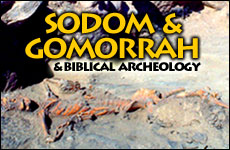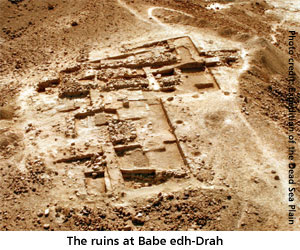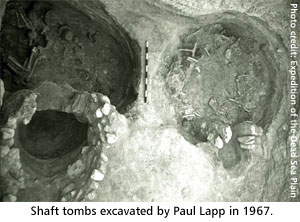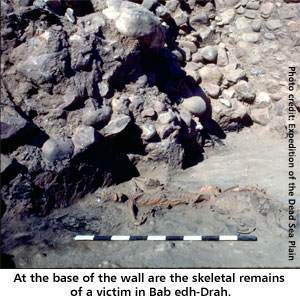 Iran’s Attack on Israel
Iran’s Attack on Israel


14 min read
Does archeological data support the Biblical story?
The Torah tells us the story of the rise and downfall of Sodom and Gomorrah. To the non-believer, the Biblical story seems so incredible that it must be relegated to the realm of myth and fantasy. The 20th-century German Bible critic, Theodor Noldeke asserted that "The whole story of Sodom and Gomorrah is unhistorical and comparatively late in origin." J. Maxwell Miller of Emory University boldly claims, "These narratives of Sodom and Gomorrah are purely products of the storyteller's art, which of course raises serious questions about their usefulness for historical reconstruction." John H. Hayes, a colleague of the aforementioned J. Maxwell Miller, confirms Professor Miller's belief. [1] Are the assertions of these skeptics based on facts or are they merely the distorted opinions of non-believers? Let us examine the facts of the case and see for ourselves.
 There are two places in the desert area near the Dead Sea that could not be more radically different from each other. One area is a dry, harsh wilderness. All that is found there are craggy hills, land strewn with crumbled rock, coarse sand, and intense heat: daytime temperatures rise to 130 degrees Fahrenheit. Rivers are few and meager. The waters of the nearby great lake are not potable: No fish live in its inhospitable waters. There are no trees to offer shade. Wayfarers are few. Snakes and scorpions are the only creatures that find comfort in this forsaken place. Desolation echoes forth from the dry river beds.
There are two places in the desert area near the Dead Sea that could not be more radically different from each other. One area is a dry, harsh wilderness. All that is found there are craggy hills, land strewn with crumbled rock, coarse sand, and intense heat: daytime temperatures rise to 130 degrees Fahrenheit. Rivers are few and meager. The waters of the nearby great lake are not potable: No fish live in its inhospitable waters. There are no trees to offer shade. Wayfarers are few. Snakes and scorpions are the only creatures that find comfort in this forsaken place. Desolation echoes forth from the dry river beds.
The second area is a great and thriving metropolis. Grain grows in abundance and precious raw materials are easily accessed. Its lush tree-shaded groves graciously bestow their blessings of fine fruits. The green canopy of its orchards stretch as far as the eye can see. There are no predatory animals to threaten passersby. The great metropolis and its citizenry are self sufficient; every need can be met locally. A veritable Garden of Eden, it is described in the Torah when Abraham and Lot decide to part ways: And Lot lifted up his eyes, and saw the valley of the Jordan, that it was well watered everywhere, before the Lord destroyed Sodom and Gomorrah, like the Garden of the Lord (Genesis 13:10).
In fact, as incredible as it may seem, the two places are one and the same. We call the area Sodom-Gomorrah. The very names of these two cities, Sodom and Gomorrah, are associated with sin and debauchery. Sodom has become a synonym for perversion. The first description of the desolate territory is the area once inhabited by the wealthy, aristocratic Sodomites as it appears today. The second description is the way it appeared earlier, at its Patriarchal Era zenith as depicted in the Talmud and the Midrash (Babylonian Talmud Sanhedrin 109a, Midrash Rabah Leviticus 5:2, Midrash Rabah Numbers 9:24.)
Sodom and Gomorrah were part of a metropolis assumed to have been located on the eastern bank of the Dead Sea consisting of five cities, each with its own king. There was (1) Bera, king of Sodom, (2) Birsha, king of Gomorrah, (3) Shinab, king of Admad, (4) Shember, king of Zeboiim, and (5) the king of Bela, which is also called Zoar (Genesis 14:8). This thriving group of city-states is referred to in the Bible (Genesis 13:12) as the Cities of the Plain. The five kings were under the dominion of a coalition of eastern Mesopotamian overlords. According to the Torah, with the help of the patriarch Abraham, the cities gained their independence, though their independence was only short-lived. A few years later, God destroyed the cities in a hail of fire and brimstone.
In the early part of the 20th century, the entire Biblical account of Sodom and Gomorrah was doubted by many academicians. Not merely the part of the story of the supernatural destruction, but also any possible rule over the area by the Mesopotamians to the east. There was no route connecting the Dead Sea area with Mesopotamia. How could the Mesopotamians have possibly conquered the area? These factors caused even those normally sympathetic to the Biblical narrative, such as William Foxwell Albright, to doubt the story.
In the early 1920s, Dr. Nelson Glueck discovered evidence of an ancient route between Mesopotamia and the Dead Sea area.
However, in the early 1920s, Dr. Nelson Glueck discovered evidence of an ancient route between Mesopotamia and the Dead Sea area. Traces of the actual route, which had been covered by the desert storms, were uncovered. Mention of the route was subsequently found in cuneiform tablets in Mari and in Ebla.
By 1924, the previously doubtful Albright became convinced of the possibility of some ancient inhabited area near the barren eastern bank of the Dead Sea. His expedition had found some meager remains of an early Bronze Age structure assumed to have been a fortress or temple. It was located on a mound, known as Bab edh-Dhra, overlooking the desert floor some 550 feet below. Albright assumed that the structure was in some way to be identified with the Sodom-Gomorrah story, but was uncertain what that connection might be.
The Five Cities of the Plain
 No serious excavations were undertaken in the area until about 40 years later. In the 1960s, a large cemetery was discovered near Bab edh-Dhra. Archeologist Paul Lapp spent three seasons excavating the area where he unearthed a great number of shaft-tombs -- possibly as many as 20,000. (A shaft-tomb is a vertical hole, about 3 feet in diameter, dug into the rocky ground to a depth of approximately 6 feet.) At the bottom of each shaft were 1-5 horizontal shallow shafts, each containing between 1-6 bodies. In addition, there were a number of mud-brick buildings, charnel houses that are repositories for bones or bodies of the dead. Each charnel house contained the remains of several hundred people.
No serious excavations were undertaken in the area until about 40 years later. In the 1960s, a large cemetery was discovered near Bab edh-Dhra. Archeologist Paul Lapp spent three seasons excavating the area where he unearthed a great number of shaft-tombs -- possibly as many as 20,000. (A shaft-tomb is a vertical hole, about 3 feet in diameter, dug into the rocky ground to a depth of approximately 6 feet.) At the bottom of each shaft were 1-5 horizontal shallow shafts, each containing between 1-6 bodies. In addition, there were a number of mud-brick buildings, charnel houses that are repositories for bones or bodies of the dead. Each charnel house contained the remains of several hundred people.
 Current estimates of the number of bodies occupying that cemetery is about a half million! Pottery shards found with the skeletal remains indicate that approximately 3,000,000 pottery vessels were used in conjunction with the burials. Other funerary items include clay figurines of goddesses, wooden staffs, sandals and reed baskets, some still containing food remains. [2] The great number of corpses in a single burial ground is evidence of a major population. But this is only the beginning.
Current estimates of the number of bodies occupying that cemetery is about a half million! Pottery shards found with the skeletal remains indicate that approximately 3,000,000 pottery vessels were used in conjunction with the burials. Other funerary items include clay figurines of goddesses, wooden staffs, sandals and reed baskets, some still containing food remains. [2] The great number of corpses in a single burial ground is evidence of a major population. But this is only the beginning.
Significantly, some forms of the pottery, jewelry, and cylinder seal impressions show a distinct Mesopotamian influence. [3] This bolsters the Biblical connection between the Dead Sea area and Mesopotamia.
 A rather obscure branch of archaeology is known as paleoethnobotany. This study examines traces of food items used by ancient cultures in order to get a perspective of the culture's agriculture and diet. Paleoenthnobotanists found in Bab edh-Dhra traces of wheat, barley, dates, plums, peaches, grapes, figs, pistachio nuts, almonds, olives, pine nuts, lentils, chick peas, pumpkin, flax seed, and watermelon. [4] It was a gourmand's delight. The healthy diet manifested itself in the physique of the inhabitants: skeletal remains indicate that a height of 5'9"-6'4" was quite normal. [5] This is a rather tall figure for such an ancient culture.
A rather obscure branch of archaeology is known as paleoethnobotany. This study examines traces of food items used by ancient cultures in order to get a perspective of the culture's agriculture and diet. Paleoenthnobotanists found in Bab edh-Dhra traces of wheat, barley, dates, plums, peaches, grapes, figs, pistachio nuts, almonds, olives, pine nuts, lentils, chick peas, pumpkin, flax seed, and watermelon. [4] It was a gourmand's delight. The healthy diet manifested itself in the physique of the inhabitants: skeletal remains indicate that a height of 5'9"-6'4" was quite normal. [5] This is a rather tall figure for such an ancient culture.
Only these five cities have been found.
Between 1973 and 1979, four more "cities" to the south of Bab edh-Dhra were found. Their Arabic names are Numeira, Safi, Feifa, and Khanazir. The surrounding area has been thoroughly explored and no other cities have been found, only these five. The five cities, a few miles apart from each other, are almost in a straight line going from north to south.
 Numeira was excavated for two seasons and the foundations of a few homes were uncovered. Perhaps the most interesting find was the remains of a winery with 4000-year-old whole grapes were still there, preserved by the arid desert climate. In latter years Moses referred to the vineyards of Sodom,For their vine is of the vine of Sodom and of the fields of Gomorrah; their grapes are grapes of gall, their clusters are bitter. (Deut. 32:32) The other three "cities" of the area have yet to be excavated. Surrounding the archeological ruins of Safi is an Early Bronze cemetery which rivals the size of Bab edh-Dhra. About nine miles south of Safi is the next of the five cities, Feifa. A cemetery has been found there too. The burial grounds of Feifa are similar in size to that of Babe edh Dhra and Safi. [6] As noted above, the cemetery of Bab edh-Dhra is reported to contain the remains of 500,000 individuals. The cemetery in Safi seems to hold the same number of corpses, another 500,000. The grounds of Feifa hold another 500,000. The cemeteries of Numeria and Khanazir have yet to be located; however, the known number of burials in this relatively small area of the Dead Sea Desert -- 1,500,000 bodies -- indicates that this was once a thriving, heavily populated area. Indeed, it does seem to be incredible, yet the evidence is there. Based on this dating of the pottery of the grave goods in Bab edh-Dhra, it seems that this city existed for about 1,000 years. Numeira, on the other hand, existed for a very short span of time, certainly less than 100 years. The Talmud (Babylonian Talmud Shabbos 11a) says that Sodom existed for a mere 52 years. This would make Numeira a likely candidate for Sodom.
Numeira was excavated for two seasons and the foundations of a few homes were uncovered. Perhaps the most interesting find was the remains of a winery with 4000-year-old whole grapes were still there, preserved by the arid desert climate. In latter years Moses referred to the vineyards of Sodom,For their vine is of the vine of Sodom and of the fields of Gomorrah; their grapes are grapes of gall, their clusters are bitter. (Deut. 32:32) The other three "cities" of the area have yet to be excavated. Surrounding the archeological ruins of Safi is an Early Bronze cemetery which rivals the size of Bab edh-Dhra. About nine miles south of Safi is the next of the five cities, Feifa. A cemetery has been found there too. The burial grounds of Feifa are similar in size to that of Babe edh Dhra and Safi. [6] As noted above, the cemetery of Bab edh-Dhra is reported to contain the remains of 500,000 individuals. The cemetery in Safi seems to hold the same number of corpses, another 500,000. The grounds of Feifa hold another 500,000. The cemeteries of Numeria and Khanazir have yet to be located; however, the known number of burials in this relatively small area of the Dead Sea Desert -- 1,500,000 bodies -- indicates that this was once a thriving, heavily populated area. Indeed, it does seem to be incredible, yet the evidence is there. Based on this dating of the pottery of the grave goods in Bab edh-Dhra, it seems that this city existed for about 1,000 years. Numeira, on the other hand, existed for a very short span of time, certainly less than 100 years. The Talmud (Babylonian Talmud Shabbos 11a) says that Sodom existed for a mere 52 years. This would make Numeira a likely candidate for Sodom.
Fire and Brimstone
Then the Lord rained upon Sodom and upon Gomorrah brimstone and fire from the Lord out of heaven. (Genesis 19:24)
 "Fire and brimstone" is a common expression used to describe the sermon of an overzealous preacher, but exactly what is brimstone? The Hebrew word for brimstone in the Biblical verse is gafrit and is usually understood to mean sulfur. The Targum Yonathan ben Uziel translates the word into Aramaic as kivraitah. The term kivraitah appears in the Talmud (Babylonian Talmud Shabbos 89b, 90a; Nidah 62a) and is used in the context of a cleaning agent. It is likely that the Biblical gafrit is the hydrocarbon bitumen, which is the essential ingredient of asphalt. Bitumen can also be distilled into a cleaning agent. Bitumen/asphalt is a naturally occurring, highly flammable substance found in the Dead Sea area. In fact, Josephus refers to the Dead Sea as Lake Asphaltites. [7] It is of interest to note that Josephus writes that the Lake Asphaltites was formed as a result of the devastation that destroyed Sodom and Gomorrah.
"Fire and brimstone" is a common expression used to describe the sermon of an overzealous preacher, but exactly what is brimstone? The Hebrew word for brimstone in the Biblical verse is gafrit and is usually understood to mean sulfur. The Targum Yonathan ben Uziel translates the word into Aramaic as kivraitah. The term kivraitah appears in the Talmud (Babylonian Talmud Shabbos 89b, 90a; Nidah 62a) and is used in the context of a cleaning agent. It is likely that the Biblical gafrit is the hydrocarbon bitumen, which is the essential ingredient of asphalt. Bitumen can also be distilled into a cleaning agent. Bitumen/asphalt is a naturally occurring, highly flammable substance found in the Dead Sea area. In fact, Josephus refers to the Dead Sea as Lake Asphaltites. [7] It is of interest to note that Josephus writes that the Lake Asphaltites was formed as a result of the devastation that destroyed Sodom and Gomorrah.
The entire areas of Bab edh-Drha and Numeira are covered with a spongy ash.
The entire areas of Bab edh-Drha and Numeira are covered with a spongy ash. These two cities show clear signs of utter destruction. The layer of ash ranges from 4-20 inches in depth. [8] Parallel to these five cities is fault line where two large plates of earth are exerting great pressure on each other. This tectonic feature has caused a number of earthquakes in the region. The pressure can also force subterranean matter, such as magma, or, in this case, bitumen into the air. Geologists suggest that, (when the time came for the destruction of Sodom -- my insertion), the earth spewed forth flammable hydrocarbons high into the atmosphere. These were ignited by lightening or some other natural source and the flaming debris fell back to earth. [9]
According to the Biblical narrative, Sodom and Gomorrah were under attack by the Mesopotamian coalition. After winning their independence from the Mesopotamians, Sodom and Gomorrah enjoyed a brief period of peace until it was destroyed in the hailstorm of fire and brimstone. The Talmud (Babylonian Talmud Shabbos 10b) states that it was only a 26 year gap between the two events.
The city of Numeira, as we conjectured, possibly Sodom, is the better preserved of the two excavated sites. Numeira shows signs of two devastations. The latter was the catastrophic fiery event that utterly destroyed the city. An earlier event shows less sign of such a catastrophe, but rather more like the result of a war. Dr. Bryant G. Wood, an expert in Syrio-Palestine archaeology, formerly of the University of Toronto, has examined the two layers of destruction. He concluded that the two events probably occurred a little more than 20 years apart. [10] His estimation is in line with the Talmud's time frame of 26 years.
Dating
There is one point that prevents this evidence of the Biblical story from being 100% conclusive. The date of the destruction of Sodom and Gomorrah according to Biblical chronology was about one year before the birth of Isaac, which was in 1712 B.C.E. The archaeological dating of the destruction of Bab edh-Dhra and Numeira is about 2300 B.C.E. [11] This discrepancy of 600 years is significant.
The dating of metal and ceramic artifacts in the Holy Land is dependant on comparisons to similar findings in Egypt. Dating Egyptian finds is far easier to estimate due to the existence of contemporary hieroglyphic writings. Archaeologists generally assume that similar type finds in the Holy Land, which are not accompanied by any written evidence, probably date to the same era as their Egyptian counterparts.
But recent evidence found by Manfred Bietak in Tel el-Daba indicates that Middle Bronze Age Canaanite artifacts lagged about 100 years behind their Egyptian counterparts. When it comes to Sodom and Gomorrah, the lag could be much more substantial because, according to the Talmud (Babylonian Talmud Sanhedrin 109a), intentional isolationism prevailed in the Cities of the Plain.
The (inhabitants of the cities of the Plain) said: "Since there cometh forth bread out of land and it hath the dust of gold, why should we suffer wayfarers, who come to us only to deplete our wealth? Come, let us abolish the practice of traveling into our land."
If, as the Talmud records, traveling into the area of Sodom and Gomorrah was sharply curtailed -- forbidden, or at least discouraged -- the introduction of outside styles of pottery and metal working would seriously fall behind the style and techniques of the more advanced Egyptians. How far the Cities of the Plain would have straggled is unknown. We must be patient and await further evidence to emerge.
Preponderance of Evidence
To summarize, the archaeology evidence as to the destruction of the five Cities of the Plain is inconclusive. However the preponderance of other evidence with regards to the Torah's story of Sodom and Gomorrah is overwhelming.
1. The Bible refers to a metropolis of five cities in the Dead Sea area.
Five, and only five cities, have been found in the Dead Sea area.
2. The Bible refers to a conquest by the Mesopotamians.
The artifacts found in the Dead Sea area show a Mesopotamian influence.
3. The Midrash describes the metropolis as a thriving population.
The enormous number of burials in the large cemeteries attests to a great population.
4. The Talmud and the Midrash describe the area as an agricultural
wonderland. The great diversity of agricultural products found in the ruins verify the lush produce enjoyed by the area's inhabitants.
5. According to the Talmud, there was a span of only 26 years between a war in the area and the ultimate destruction.
Devastation levels found in Numeira (Sodom) are consistent with the Talmud's assertion.
6. The Talmud states that Sodom, unlike other cities in the area, only existed for 52 years.
The ruins in Numeira (Sodom) indicate that the city lasted less than 100 years.
7. The Bible attributes the destruction of the cities to a fiery storm that rained down from above.
Thick layers of burnt material covering the remains of the cities in the area bear this out.
After reviewing all of the archaeological data, it is quite clear that the story related in the Torah and Midrash is completely accurate in spite of what the non-believers may boldly claim.
Footnotes
